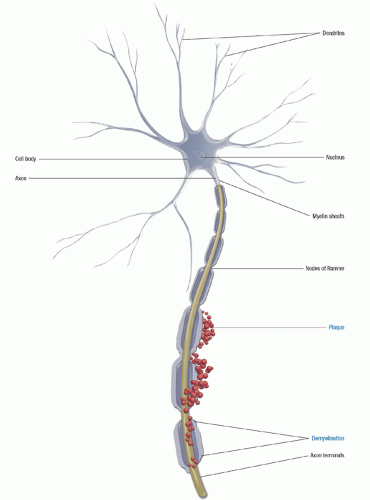male gender, poorer prognosis is associated with age of onset over 40 years; initial presentation of motor, cerebellar, or sphincter symptoms or polysymptomatic presentation; frequent attacks in the first 5 years; and a short interval between attacks.6
TABLE 32-1 FOUR CATEGORIES OF MULTIPLE SCLEROSIS (MS) BASED ON CLINICAL COURSE | ||||||||||
|---|---|---|---|---|---|---|---|---|---|---|
|
to explain the variations in symptoms that occur with MS throughout a day or a week and in relationship to activity or illness.
Sensory symptoms: numbness or sensory loss; paresthesia (burning, prickling, tingling); pain; decreased proprioception and perception of temperature, depth, and vibration.
Motor symptoms: paresis, paralysis, dragging of foot; spasticity; diplopia; bladder and bowel dysfunction (incontinence or retention).
Cerebellar symptoms: ataxia; loss of balance and coordination; nystagmus; speech disturbances (dysarthria, dystonia, scanning speech, slurred speech); tremors (intentional tremors, described as tremors that increase when a purposeful act is initiated); vertigo.
Other symptoms: fatigue; optic neuritis; eye movement disorders; tremor; respiratory disturbance; dysphagia; sleep disorders; neurogenic bowel or bladder; impotence or decreased genital sensation and sexual dysfunction; cognitive dysfunction; neurobehavioral disorders such as depression, anxiety, or euphoria. Less common symptoms include tonic spasms, visual loss, trigeminal neuralgia, facial palsy, and impotence.
dyssynergia (failure to empty), or a combination of the two. Constipation is the most common bowel complaint, with fecal incontinence occurring less frequently. Sexual dysfunction is caused by loss of sensation; fatigue, weakness, pain, or spasticity in the legs; erectile dysfunction and/or ejaculatory dysfunction in men; loss of lubrication and/or orgasm in women; medication side effects; psychologic effect; or loss of libido.
Stay updated, free articles. Join our Telegram channel

Full access? Get Clinical Tree




